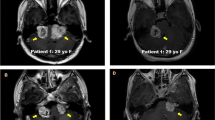Abstract
Background
Segmental neurofibromatosis type 1 (NF-1) has the characteristic features of generalized NF-1 but is isolated to a particular segment of the body. Segmental NF-1 results from a postzygotic mutation during embryogenesis in the NF-1 gene on chromosome 17. The embryologic timing of the mutation and cell types affected predict the clinical phenotype.
Objective
We present a case of a 52-year-old woman with segmental neurofibromas isolated to the right cheek and neck. We review the recent literature on the genetic and cellular differences between the various clinical manifestations of segmental NF-1.
Methods
A MEDLINE search for cases of segmental neurofibromatosis was conducted.
Results
In patients with segmental NF-1 presenting as neurofibromas-only, the distribution follows a neural distribution in dermatomes because the genetic mutation appears to be limited to Schwann cells. In patients with pigmentary changes only, the NF-1 mutation has been shown to occur in fibroblasts and the distribution tends to follow the lines of Blaschko.
Conclusion
Our patient’s neurofibromas were secondary to a postzygotic mutation in the NF-1 gene of neural crest–derived cells. This mutation most likely occurred later in embryogenesis in cells that had already differentiated to Schwann cells and were committed to the dermatomal distribution of the right neck and cheek region (C2).
Sommaire
Antécédents
La neurofibromatose périphérique de type 1 segmentaire, ou encore NF-1 segmentaire, présente les caractéristiques générales d’une NF-1 tout en étant isolée à une zone particulière du corps. La NF-1 segmentaire résulte d’une mutation post-zygotique durant I’embryogènese dans le gène NF-1 , sur le chromosome 17. La période de la mutation embryologique et les types de cellules affectées prédisent le phénotype clinique.
Objectif
Nous étudions le cas d’une femme de 52 ans presentant des neurofibromes segmentaires isolés à la joue et au cou du côté droit. Nous passons en revue les récentes publications portant sur les différences génétiques et cellulaires entre les diverses manifestations de la NF-1 segmentaire.
Methodes
Une recherche des cas de neurofibromatose segmentaire dans la base de données MEDLINE a été effectuée.
Resultats
Chez les patients ayant une NF-1 segmentaire se manifestant sous forme de neurofibromes seulement, la distribution suit une distribution neurale des dermatomes car la mutation génétique semble se limiter aux cellules de Schwann. Chez les patients qui souffrent uniquement d’un changement pigmentaire, il a été démontré que la mutation NF-1 a lieu dans les fibroblastes et la distribution a tendance à suivre les lignes de Blaschko.
Conclusion
Les neurofibromes de notre patiente étaient consécutifs à une mutation post-zygotique dans le gène NF-1 de cellules dérivées de la crête neurale. II est très probable que cette mutation ait eu lieu plus tard durant l’embryogenèsè des cellules qui s’étaient déjà spécialisées en cellules de Schwann et avaient deja été rattachées au cou et à la joue, du côté droit (C2).



Similar content being viewed by others
References
M Ruggieri SM Huson (2001) ArticleTitleThe clinical and diagnostic implications of mosaicism in the neurofibromatoses Neurology 56 IssueID11 1433–1443 Occurrence Handle11409413
VM Riccardi (1982) ArticleTitleNeurofibromatosis: clinical heterogeneity Curr Probl Cancer 7 1–34
R Happle (1991) ArticleTitleSegmental neurofibromatosis and germ-line mosaicism Hautarzt 42 IssueID12 739–740 Occurrence Handle1765487
S Tinschert I Naumann E Stegmann et al. (2000) ArticleTitleSegmental neurofibromatosis is caused by somatic mutation of the neurofibromatosis type 1 (NF1) gene Eur. J. Hum Genet 8 455–459 Occurrence Handle10.1038/sj.ejhg.5200493 Occurrence Handle10878667
ES Schultz D Kaufman S Tinchert et al. (2002) ArticleTitleSegmental neurofibromatosis Dermatology 204 IssueID4 296–297 Occurrence Handle10.1159/000063363 Occurrence Handle12077526
E Serra T Rosenbaum U Winner et al. (2000) ArticleTitleSchwann cells harbor the somatic NF1 mutation in neurofibromas: evidence of two different schwann cell subpopulations Hum Mol Genet 9 IssueID20 3055–3064 Occurrence Handle10.1093/hmg/9.20.3055 Occurrence Handle11115850
L Kluwe RE Friedrich VE Mautner (1999) ArticleTitleAllelic loss of the NF1 gene in NF1-associated plexiform neurofibromas Cancer Genet Cytogenet 113 IssueID1 65–69 Occurrence Handle10.1016/S0165-4608(99)00006-0 Occurrence Handle10459349
R Happle A Assim (2001) ArticleTitleThe lines of Blaschko on the head and neck J Am Acad Dermatol 44 IssueID4 614 Occurrence Handle10.1067/mjd.2001.112386
Author information
Authors and Affiliations
Corresponding author
About this article
Cite this article
Redlick, F.P., Shaw, J.C. Segmental Neurofibromatosis Follows Blaschko’s Lines or Dermatomes Depending on the Cell Line Affected: Case Report and Literature Review. J Cutan Med Surg 8, 353–356 (2004). https://doi.org/10.1007/s10227-005-0029-z
Published:
Issue Date:
DOI: https://doi.org/10.1007/s10227-005-0029-z




